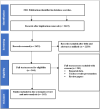Global prevalence and antibiotic resistance profiles of carbapenem-resistant Pseudomonas aeruginosa reported from 2014 to 2024: a systematic review and meta-analysis
- PMID: 40761277
- PMCID: PMC12318982
- DOI: 10.3389/fmicb.2025.1599070
Global prevalence and antibiotic resistance profiles of carbapenem-resistant Pseudomonas aeruginosa reported from 2014 to 2024: a systematic review and meta-analysis
Abstract
Introduction: Carbapenem-resistant Pseudomonas aeruginosa (CRPA) represents a global threat, but the global distribution of carbapenem resistant bacteria remains a critical issue in public health.
Methods: We conducted a systematic review and meta-analysis on the global pooled prevalence estimate (PPE) of CRPA and their antibiotic resistance. The systematic review protocol was registered with PROSPERO (CRD42024579654). This study was carried out following the preferred reporting items for systematic reviews and meta-analyses (PRISMA) guidelines. Heterogeneity between studies was assessed using Cochrane Q test and I2 test statistics based on the random effects model. Comprehensive meta-analysis software v4.0 was used to analyze the pooled prevalence of CRPA.
Results: A total of 163 studies (both clinical and screening samples) containing a total of 58,344 cases from 39 countries were included in this study. The overall PPE of CRPA was 34.7% (95% CI: 0.316-0.37.8) for both clinical and screening samples. Meropenem had a PPE of 31.2% (95% CI: 0.272-0.352) and imipenem had the lowest PPE of 27.7% (95% CI: 0.238-0.319). Japan had the highest PPE at 98.2% (95% CI: 0.482-0.100) of CRPA, and the lowest was observed for Saudi Arabia at 13.9% (95% CI: 0. 064-0. 277). CRPA is widespread on five continents except Australia and Antarctica, while the highest PPE is in Europe at 47.6% (95% CI: 0.359-0.595) and the lowest in Asia at 32, 8% (95% CI: 0.293-0.364). The relatively higher PPE of CRPA was observed in Europe during the year interval 2014-2017 at 95.4% (95% CI: 0.388-0.999), followed by Africa from the year 2022-2024 with 38.5% (95% CI: 0.243-0.550). Ceftazidime was significantly higher in studies conducted before 2019 with a PPE of 44.7% (95% CI: 0.246% - 0.668), while CRPA after 2019 had a higher resistance to cefoperazone/sulbactam with a PPE of 17.3% (95% CI: 0.050-0.455).
Discussion: This review indicates that the prevalence of CRPA is generally high and varies significantly between countries. To prevent the emergence of CRPA and antibiotic resistance, future initiatives should prioritise strengthening laboratory capacity for early detection of antibiotic resistance.
Keywords: CRPA; antibiotic resistance; global; meta-analysis; pooled prevalence estimate.
Copyright © 2025 Ramatla, Nkhebenyane, Lekota, Thekisoe, Monyama, Achilonu and Khasapane.
Conflict of interest statement
The authors declare that the research was conducted in the absence of any commercial or financial relationships that could be construed as a potential conflict of interest.
Figures



Similar articles
-
Falls prevention interventions for community-dwelling older adults: systematic review and meta-analysis of benefits, harms, and patient values and preferences.Syst Rev. 2024 Nov 26;13(1):289. doi: 10.1186/s13643-024-02681-3. Syst Rev. 2024. PMID: 39593159 Free PMC article.
-
The prevalence of vancomycin-resistant Staphylococcus aureus in Ethiopia: a systematic review and meta-analysis.Antimicrob Resist Infect Control. 2023 Aug 30;12(1):86. doi: 10.1186/s13756-023-01291-3. Antimicrob Resist Infect Control. 2023. PMID: 37649060 Free PMC article.
-
Intravenous magnesium sulphate and sotalol for prevention of atrial fibrillation after coronary artery bypass surgery: a systematic review and economic evaluation.Health Technol Assess. 2008 Jun;12(28):iii-iv, ix-95. doi: 10.3310/hta12280. Health Technol Assess. 2008. PMID: 18547499
-
Systemic pharmacological treatments for chronic plaque psoriasis: a network meta-analysis.Cochrane Database Syst Rev. 2021 Apr 19;4(4):CD011535. doi: 10.1002/14651858.CD011535.pub4. Cochrane Database Syst Rev. 2021. Update in: Cochrane Database Syst Rev. 2022 May 23;5:CD011535. doi: 10.1002/14651858.CD011535.pub5. PMID: 33871055 Free PMC article. Updated.
-
Systemic pharmacological treatments for chronic plaque psoriasis: a network meta-analysis.Cochrane Database Syst Rev. 2020 Jan 9;1(1):CD011535. doi: 10.1002/14651858.CD011535.pub3. Cochrane Database Syst Rev. 2020. Update in: Cochrane Database Syst Rev. 2021 Apr 19;4:CD011535. doi: 10.1002/14651858.CD011535.pub4. PMID: 31917873 Free PMC article. Updated.
References
-
- Abdalhamid B., Elhadi N., Alabdulqader N., Alsamman K., Aljindan R. (2016). Rates of gastrointestinal tract colonization of carbapenem-resistant Enterobacteriaceae and Pseudomonas aeruginosa in hospitals in Saudi Arabia. New Microbes New Infect. 10, 77–83. doi: 10.1016/j.nmni.2016.01.014, PMID: - DOI - PMC - PubMed
-
- Abubakar U., Zulkarnain A. I., Rodríguez-Baño J., Kamarudin N., Elrggal M. E., Elnaem M. H., et al. (2022). Treatments and predictors of mortality for carbapenem-resistant gram-negative bacilli infections in Malaysia: a retrospective cohort study. Trop. Med. Infect. Dis. 7:415. doi: 10.3390/tropicalmed7120415, PMID: - DOI - PMC - PubMed
-
- Acar A., Karaahmetoğlu G., Akalın H., Altay A. F. (2019). Pooled prevalence and trends of antimicrobial resistance in Pseudomonas aeruginosa clinical isolates over the past 10 years in Turkey: a meta-analysis. J. Glob. Antimicrob. Resist. 18, 64–70. doi: 10.1016/j.jgar.2019.01.032, PMID: - DOI - PubMed
-
- Al-Abedi K. J. H., Al-Mayahi F. A. (2019). Molecular detection of serine carbapenemase genes in carbapenem-resistant isolates of Pseudomonas aeruginosa recovered from patients in Al-Diwaniyah Province, Iraq. Iraq J. Pure Appl. Microbiol. 13, 1775–1782. doi: 10.22207/JPAM.13.3.53 - DOI
Publication types
LinkOut - more resources
Full Text Sources

